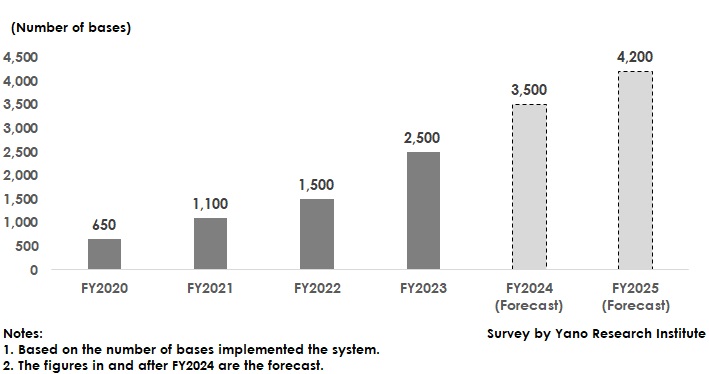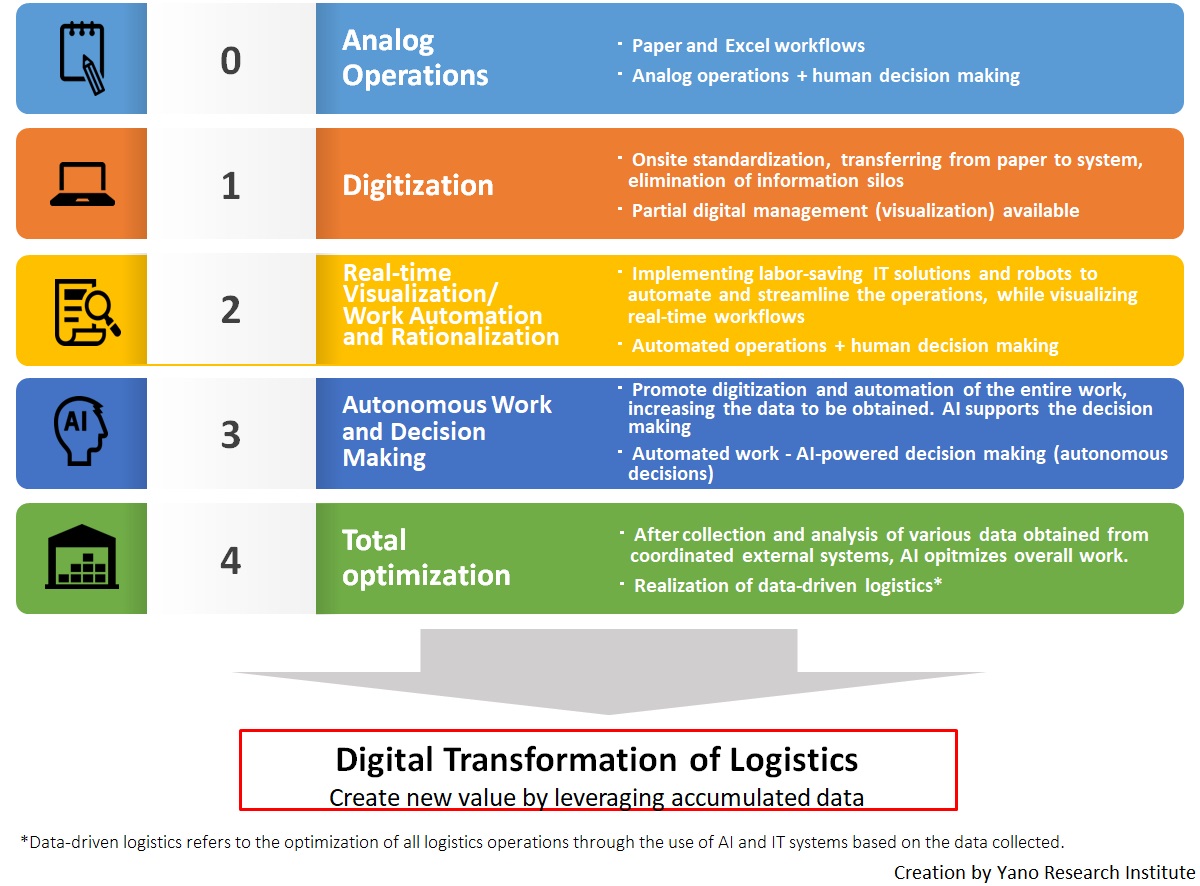No.3634
Warehouse Logistics Tech Market in Japan: Key Research Findings 2024
Size of Space/Berth Scheduling System Market by Number of Bases Implemented Grew to 2,500 Bases in FY2023, 167% of Previous Fiscal Year
Yano Research Institute (the President, Takashi Mizukoshi) has surveyed the domestic warehouse logistics technology market and found out market trends by category, trends of market players, and future outlook. Here are the analysis results for space/berth scheduling systems.


Market Overview
The logistics industry, which supports the social infrastructure, is labor-intensive and therefore has a more serious labor shortage, while various efforts are needed and have been made, such as limiting the overtime cap for drivers, responding to the demand for carbon neutrality, etc. In such a situation, the adoption of IT logistics tech system, which aims at the overall warehouse work efficiency, including efficient warehouse management and control of automation equipment, is attracting attention. The adoption of logistics tech system not only contributes to the reduction of physical workload and labor saving, but it also digitizes logistics workflows into data to be accumulated and eliminates manual operations. However, the cost of development and implementation, the shortage of IT personnel at the time of adoption and implementation have limited the adoption to large companies with sufficient investment capacity and IT department and personnel in-house or within their group companies. In recent years, however, logistics SaaS solutions have become available that allow the adoption of standardized software packages, increasing the adoption in midsize companies.
Among various warehouse logistics tech systems, this press release addresses the market for berth/space scheduling systems that control trucks entering and exiting warehouses.
The size of the berth/space scheduling system market, based on the number of bases implemented, is estimated to grow 167% from the previous fiscal year to 2,500 bases in FY2023. There has been an increase in the number of implementations aimed at reducing driver workload and waiting time. Some transportation companies have also implemented the system at their other bases. Adoption of the system by transportation companies has led to new implementations at client sites aimed at visualizing the real-time status of freight, which has increased the number of bases implementing the system. As the adoption of the system continues to grow steadily, the market is expected to expand through FY2025.
Noteworthy Topics
Yano Research Institute has originally summarized the logistics digitalization phase in Japan into five phases (“Warehouse Logistics Digitalization Phases” diagram).
“Step 0 (zero)” refers to onsite analog management, “Step 1” refers to initiating onsite digitization by transferring from paper to IT system, “Step 2” refers to onsite visualization of real-time process and automating and streamlining of work by implementing IT solutions and robots, “Step 3” refers to onsite partial decision making by AI in addition to automated workflows, and “Step 4” refers to autonomous optimization of overall onsite operations by coordinating with external IT systems outside the warehouse.
In general, the current phase is the implementation of warehouse workflow digitalization. Large logistics companies are in the process of implementing labor-saving IT solutions and robots to automate and streamline the warehouse operations, while visualizing real-time workflows. They have started to address “Step 3: Autonomous work and decision making” based on the data they have obtained. Along with further automation, they are expected to advance data-driven logistics by optimizing the entire logistics operations through AI and IT systems based on the collected data.
Medium-sized companies have started to work on “Step 2: Real-time workflow visualization /work automation and rationalization”. Their data to be visualized is expected to increase as the number of processes for system and robot implementation increases.
However, SMEs, which make up the largest number of companies in Japan, are still in “Step 1: Digitization”, where they are in the middle of transferring their analog operations to digitalized management. To create new value through data integration and to promote the digital transformation of logistics that enables efficient operations and decision-making, it is essential to standardize the warehouse sites and advance digitalization at SMEs.
As the number of warehouse workers will certainly decrease in the future, warehouse work is no exception to the problem of labor shortage. To facilitate the work to be performed by a smaller number of personnel than today, it is necessary to create new designs. The use of IT systems and robots is essential to save labor. It is not enough to introduce the latest IT technology in warehouses. It is important to train and educate IT personnel in-house to use new technologies to anticipate the future from an early stage.
Research Outline
2.Research Object: Logistics systems and logistics service providers
3.Research Methogology: Face-to-face interviews (including online) by specialized researchers, questionnaire, and literature research
What is Logistics Tech Market?
Logistics technology or logistics tech refers to the systems and services that use the latest technologies such as cloud, voice/speech recognition, AI, radio frequency identification (RFID), etc. to improve work efficiency in logistics. The logistics tech market in this research indicates the market of warehouse software, cloud-based warehouse management system (WMS), warehouse execution system (WES), berth/space scheduling system, warehouse work visualization/analysis system, etc. Here are the analysis results of space/berth scheduling systems. Note that a space/berth scheduling system is the system that allows a truck entering or leaving a logistics center to reserve a piece of space (that is called a berth in Japan) in advance for its loading or unloading work, and to register when the truck arrives at the center.
<Products and Services in the Market>
WMS, WES, berth/space scheduling system, warehouse work visualization/analysis system, voice/speech recognition system, AI, RFID
Published Report
Contact Us
The copyright and all other rights pertaining to this report belong to Yano Research Institute.
Please contact our PR team when quoting the report contents for the purpose other than media coverage.
Depending on the purpose of using our report, we may ask you to present your sentences for confirmation beforehand.